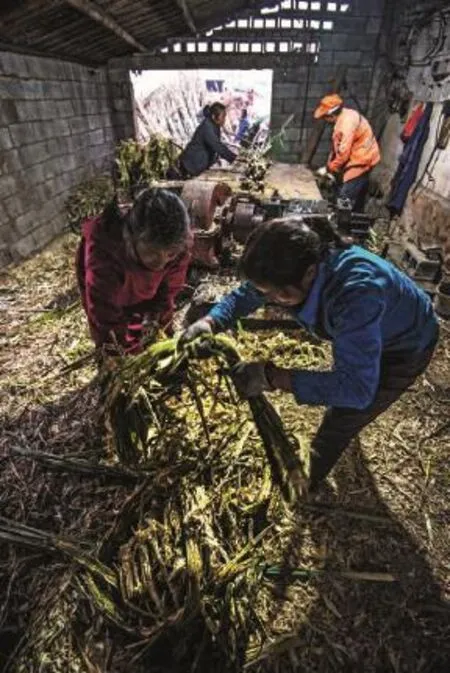THE SACCHARINE SOUTH
2014-02-27
THE SACCHARINE SOUTH
PHOTOGRAPHS BY MENG QINGCHUN (孟庆春) ,
TEXT BY LIU JUE (刘珏)

Sugarcane harvested and ref i ned the old fashioned way
甘蔗成熟的季节,江西小村庄的古法制糖也再次苏醒了
Starting in mid-October, on farm fi elds scattered among the hilly areas of southern Jiangxi Province, farmers begin their annual harvest of sugarcane. Like many other places in China's countryside, such a task is still only done through arduous labor, with families intensively reaping their scythes day and night. In Aoshang (坳上), bundles of sugarcane with a distinct purple luster are stacked neatly outside a grey break house. Instead of conveniently selling them to big factories, the villagers choose to make sugar on their own using a centuries-old traditional method.
The break house, a community workshop, burns sugarcane leaves non-stop for the entire month of November to fuel sugar production. The ancient method largely remains the same: the sugarcane is fi rst crushed with a stone mill or machine to yield juice, which will later be boiled. Inside the workshop, senior masters with rich experience oversee the heat and timing of the boiling process, and all family members and friends come to help. The caldron stays full until each family has turned their bundles of cane into buckets of brown sweetness. This is not just any sugar they are making; crafted brown cane sugar or “red sugar” (红糖) is a highly-valued local specialty for its natural aroma, nutritional value, health effects, and restorative power for women, especially those who have just experienced childbirth, according to traditional Chinese medicine beliefs. Though sugar is without a doubt one of the most common and cheapest condiments today, red sugar is sold for as high as 26 to 30 RMB per kilogram, with each family only producing 50 to 100 kilogram a year. The locals include red sugar as an essential part of their diet; its making certainly has an important spot on the village's yearly calendar, giving the activity a festival mood that's all too rare in today's modern urban experience.

STACkS OF NEWLY HARVESTED SUGARCANE WAIT IDLE IN THE COMMUNITY SUGAR WORkSHOP

LEAVES ARE SEPARATED AND DRIED BUT NOT WASTED. LATER, IT WILL SERVE AS THE FUEL FOR THE SUGAR-MAkING PROCESS.

SUGARCANE IS FIRST CRUSHED TO YIELD JUICE

THE WORkSHOP STOVE WILL BURN NONSTOP FOR AN ENTIRE MONTH FOR EVERY FAMILY IN THE VILLAGE TO MAkE SUGAR

THE CALDRON IS DIVIDED INTO DIFFERENT SECTIONS AND HEATED DIFFERENTLY. SUGARCANE JUICE IS BOILED AND MOVED THROUGH DIFFERENT SECTIONS FOR GRADUAL CONCENTRATION.

WHILE BOILING, A SENIOR MASTER OVERSEES THE PROCESS, STIRRING CONSTANTLY AND MOVING THE JUICE FROM SECTION TO SECTION WHEN THE TIMING IS RIGHT

THE SUGARCANE JUICE IS FILTERED THROUGH A NET, AND THE VILLAGERS COLLECT THE RESIDUE TO SELL TO FACTORIES WHERE IT CAN BE PROCESSED FURTHER

WHEN THE JUICE IS SUFFICIENTLY CONCENTRATED, IT IS PUT IN A WOODEN BASIN TO COOL DOWN. VILLAGERS THEN GATHER THE LIQUID SUGAR WITH SMALL BUCkETS OR BOTTLES, WHICH THEY WILL SAVE FOR THEMSELVES OR SELL AS A FAMOUS LOCAL SPECIALTY.

BROWN CANE SUGAR
Because it's unrefined, brown cane sugar retains natural vitamins and minerals, but according to traditional Chinese medicine beliefs, this sugar also nourishes blood andqi, activates circulation, and warms the spleen and stomach. Women recovering from childbirth are often advised to drink brown sugar water for the above benefits. Brown sugar ginger tea (红糖姜茶) is also a comforting drink for women suffering from cramps, and many testify to its pain reliving attributes.
